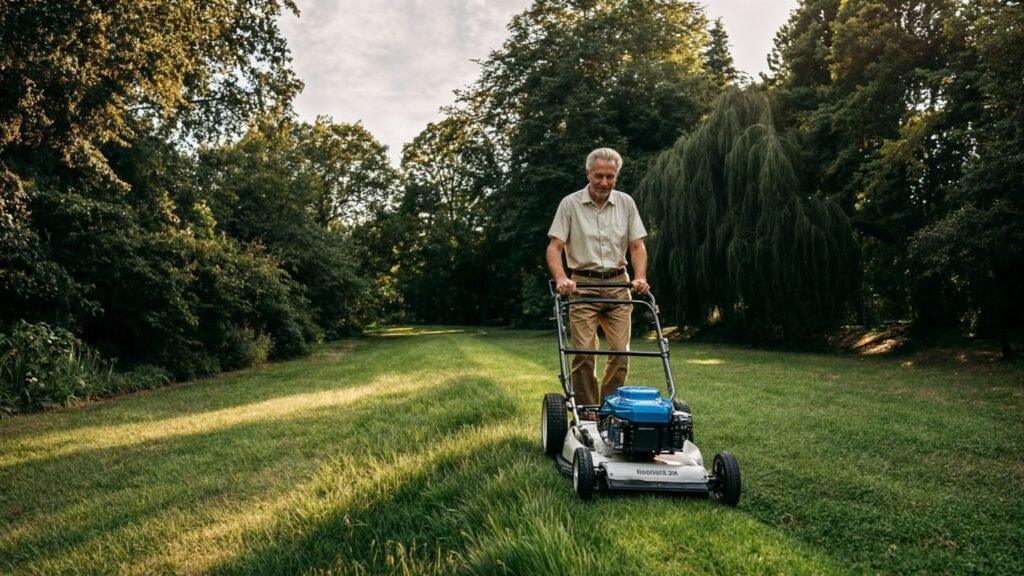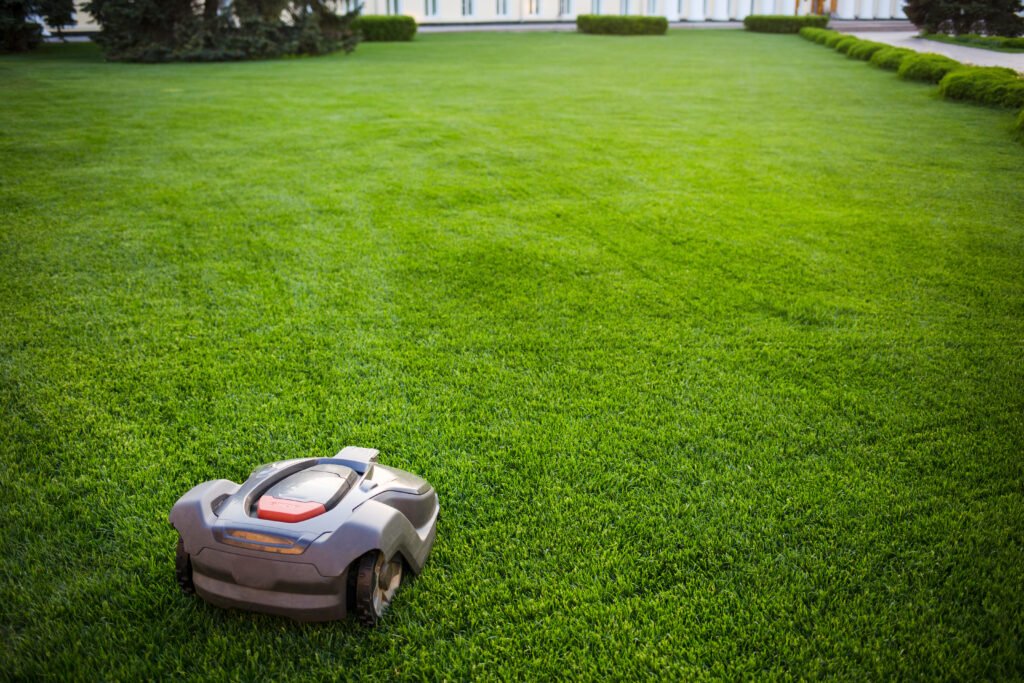Commercial Robotic Mowers vs Traditional are changing the landscape of business outdoor maintenance. Residential robot mowers handle between 0.25 to 2.5 acres, but commercial models manage 2 to 10+ acres per unit and work with multiple units in fleets. This significant gap in capabilities shows the fundamental differences between these categories.
Our experience in the lawn care industry shows how commercial robotic mowers have become essential tools rather than optional equipment. These machines excel at professional lawn management for sports fields, golf courses, and public green spaces. The environmental advantages are significant – Husqvarna’s commercial robotic mowers run at 60 decibels, which makes them 33% quieter than standard gas mowers that operate at 90 decibels. Belrobotics and other manufacturers use advanced GPS technology that delivers centimeter-level precision without boundary wires.
This piece compares commercial robotic mowers with conventional options based on business owners’ feedback. Readers will discover what defines commercial-grade equipment, its real-life performance, and the ROI it generates for businesses with large outdoor spaces.
What Makes a Mower Commercial-Grade?

The difference between commercial and residential mowers is nowhere near just price or brand name. Professional-grade equipment must meet strict standards to handle daily professional use.
Durability and build quality
Commercial mowers are built like tanks. They come with welded frames instead of bolted ones and use heavy-duty materials that stand up to constant use in tough conditions. Professional models use 7-gauge welded steel for decks that’s much thicker than what you’ll find in residential models. This solid construction means these machines can take bumps, rough terrain, and years of heavy use without failing. These units also feature cast-iron spindle housings and reinforced caster wheels that absorb shock and resist wear.
Engine power and runtime
Commercial riding mowers pack engines from 23 to 35 horsepower to tackle large properties and tough conditions. This power delivers faster blade speeds and smoother cuts that handle thick grass without slowing down. Unlike residential models, commercial engines have tougher components like cast-iron cylinder bores, bigger air filters, and better cooling systems. Many top models now use Electronic Fuel Injection (EFI) technology that uses 25% less fuel and delivers steady power at different speeds and heights.
Cutting deck size and speed
Professional use works best with deck sizes between 48 to 72 inches, based on property size. Experts suggest 60 to 72-inch decks with 30+ horsepower engines for properties between one and ten acres. A 60-inch zero-turn riding mower at 6 mph can cut an acre in just 20 minutes, adding up to 24 acres in an eight-hour workday. The right deck size makes a huge difference in efficiency and profit.
Designed for frequent, long-term use
Commercial mowers put operator comfort first to help reduce fatigue during long days. These machines come with adjustable seats, armrests, suspension systems, and easy-to-use controls. Brands like Ferris have created new suspension technologies that keep stability on slopes and improve operator comfort. Easy maintenance access matters most—you’ll find tool-free belt adjustments, flip-up decks, and quick access to filters and oil systems. Manufacturers back their commercial equipment with special professional-use warranties that set them apart from residential models.
How Traditional Commercial Mowers Perform in the Field
Traditional commercial mowers are the industry standard, but their ground performance creates big challenges for business owners.
Manual labor and operator fatigue
Traditional commercial mowers take a physical toll on workers. Workers who face long-term exposure to whole-body vibration and hand-arm vibration can develop recognized industrial disorders like Hand-Arm Vibration Syndrome. This affects their blood vessels, nerves, muscles, and joints. Operator fatigue causes most mower-related injuries, especially during long work hours. Workers become less aware as the day goes on and might take dangerous shortcuts with safety protocols. They slow down to handle rough terrain, which cuts into productivity but doesn’t reduce their physical strain.
Fuel and maintenance costs
The costs of traditional mowers go way beyond the purchase price. Gas-powered commercial mowers use about one gallon of fuel per hour at $3.50 per gallon. A 60-inch riding mower costs around $15.66 per hour to run when you add up acquisition (55%), maintenance (23%), and fuel (22%). The mowers also need regular oil changes, new air filters, spark plug replacements, and fuel system maintenance. These maintenance needs add $3.34 per hour to running costs.
Noise and environmental impact
These mowers are noisy machines that run at 85-90 decibels—loud enough to harm hearing over time. This noise pollution travels far, with sound above WHO outdoor standards (55 dB) reaching up to 800 feet from the mower. Gas-powered mowers are also major polluters, making up 5% of total U.S. air pollution according to the EPA. A bestselling lawn mower running for one hour pollutes as much as driving a 2016 Toyota Camry for over 300 miles.
Performance on large or uneven terrain
Power alone doesn’t help these mowers handle tough landscapes. Lap-bar zero-turns with passive front casters slide downhill on slopes, and single-wheel drive systems can’t get enough grip. Mowers risk tipping over on slopes steeper than 15 degrees. Operators struggle against physics on hillsides, which leads to less efficiency, damaged turf, and more strain on the operator.
How Commercial Robotic Lawn Mowers Are Changing the Game
Modern technology is transforming commercial lawn care through autonomous robotic mowers that work with amazing precision.
Autonomous operation and smart scheduling
The newest commercial robotic mowers work on their own. The Mean Green Vanquish Autonomous comes with self-driving technology for ground commercial needs. These mowers follow set schedules and adapt to changing conditions. Husqvarna’s Automower Connect app lets operators create custom cutting patterns with parallel stripes and checkerboard designs. These systems also watch weather forecasts and automatically dock when they detect rain to protect the turf.
RTK GPS and virtual boundaries
RTK (Real-Time Kinematic) positioning technology stands out as the most important advancement. Unlike older models that needed physical boundary wires, RTK-equipped mowers like Husqvarna’s EPOS™ system are accurate to the centimeter using satellite navigation. This precision creates virtual boundaries that users can easily change through smartphone apps. The system combines satellite positioning with sensor data and works reliably even with tree cover or buildings nearby.
Fleet management and remote diagnostics
Commercial robotic mowers now blend with complete fleet management platforms. Husqvarna Fleet Services™ helps managers track entire fleets, monitor location, performance metrics, and maintenance needs from any device. ECHO’s MyRobot portal gives live alerts, remote commands, and detailed analytics. These platforms send commands to multiple units and notify immediately if problems arise.
Battery-powered and eco-friendly
Commercial robotic mowers bring impressive environmental benefits without direct emissions. Greenworks’ OptimusZ runs up to 8 hours straight and cuts maintenance costs by up to 90% compared to gas mowers. These mowers run quietly at around 60 decibels, making them perfect for hospitals and schools.
Real-life examples: Husqvarna and Belrobotics in action
Husqvarna’s Automower 580 EPOS shows what advanced commercial mowers can do. It manages up to 16,000 m² (about 4 acres) while creating professional striped patterns. ECHO’s TM-2050 autonomous mower maintains up to 15 acres with three cuts weekly. Its small clippings naturally fertilize the soil. These systems work great, especially when you have sports fields, golf courses, and multiple properties to manage.
Business Owner Insights: Real Results and ROI

Businesses that use commercial robotic mowers see major financial and operational benefits that boost their profits.
Labor cost savings and reallocation
The data tells a compelling story. Companies using commercial-grade robotic mowers save $5,000-$15,000+ yearly per location. A landscaping company saw its labor hours drop by 92% after switching to remote-operated robotic technology. Golf courses using Husqvarna robotic mowers cut their labor costs from $28,800 to just $3,000—a 96% reduction. The core team, once tied up with mowing, can now handle valuable services like edging, pruning, and landscape design.
Improved lawn consistency and appearance
Commercial robotic lawn mowers cut grass frequently and precisely, leading to healthier and more uniform turf. Cornell’s Turfgrass Program research shows that autonomous mowing helps common grasses grow thicker with more shoots. The small grass clippings work as natural mulch that enriches the soil and reduces the need for fertilizers.
Reduced downtime and maintenance
Robotic technology slashes operating costs. Traditional mowers use 1-2 gallons of fuel per hour at $3.50 per gallon. In contrast, robotic mowers need less than $100 in charging costs for a full growing season. The yearly maintenance bill drops from about $5,000 for gas mowers to just $600 for robotic models.
Scalability for multi-property management
Companies can monitor multiple mowers at different sites at once with fleet management features. A single large-scale autonomous mower maintains 20-30 acres weekly. This makes Belrobotics’ commercial robotic mowers and similar systems perfect for businesses that manage many properties.
Conclusion
Commercial robotic mowers represent what a world of professional lawn care looks like. Our exploration shows these machines outperform their traditional counterparts in every aspect that matters to business owners. Without doubt, autonomous operations paired with RTK GPS technology have revolutionized commercial landscaping possibilities.
The numbers make a compelling case to switch. Ground case studies show labor costs dropping by up to 96%, while maintenance costs decrease from $5,000 to $600 yearly. These machines run quietly at 60 decibels compared to gas models’ 90 decibels and produce zero direct emissions.
Teams can now focus on specialized services that bring more value to clients since mowing duties are automated. Landscape businesses can expand their services without hiring more staff through this resource reallocation.
Robotic mowers’ consistent and frequent cutting patterns lead to healthier turf and denser lawns that need less fertilizer. The fleet management features make these systems perfect for companies managing multiple properties.
Moving from traditional to robotic mowing needs an original investment and adaptation period. The financial and operational benefits make this change logical for forward-thinking landscape businesses in the long run. Commercial robotic mowers have evolved beyond interesting novelties. They are now essential tools for companies that want to maximize their lawn care operations’ efficiency, quality, and profitability.


